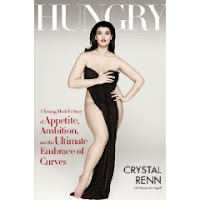Hungry by Crystal Renn discusses how a young woman working in the modeling industry develops an eating disorder under the pressure to be thin to get work and how she conquers it through her own will and determination. Renn tells the story of her transformation from an unhappy, hungry and unsuccessful model to the successful, internationally acclaimed, confident and happy plus-sized model she is today. Renn serves as an inspiration for size acceptance to women everywhere.
There are many campaigns promoting healthy body image from the Dove Campaign for Real Beauty to Fat Talk Free Week, a campaign to promote the end of body-centric comments which can have a negative impact on body image and possibly lead to eating disorders. With the fashion industry, it seems that changing the focus from thin to healthy is an uphill battle.
I interviewed professional model and registered dietitian, Maye Musk, MS, RD, about the modeling industry and how she navigates her role as both a model and a nutritionist. Musk's comments are candid and humorous. She states that health and the health of models are not truly important to the fashion industry. Clothes are made in one size and the models must fit into these clothes. Somewhere along the line someone decided that clothes look better on smaller models. Musk defines these finer boned models as "freaks of nature." This is her humorous way of stating that very few women naturally have the body type to wear the clothes that are being designed. "The clothes are made for skinny 12 year old boys," she says. To get a chance to model these clothes, young models starve themselves. "You can see the muscle wasting on the arms and thighs. The models are truly emaciated."
In her nutrition practice, Musk counsels ballet dancers, actors and models, many of whom are trying to obtain this unrealistic ideal. She counsels them on the value of good nutrition and how beauty relates to it. She states that "general good health provides the energy to model." That energy in turn translates the model's movements into a beautiful work of art. The movement of a healthy model in clothing has the power to captivate, so that even a still photo is dynamic. To model, Musk claims, one needs to look fabulous. The amount of fat doesn't matter.
The modeling industry has adopted the minimum healthy Body Mass Index (BMI) for its models which is 18.5 kg/m2. BMI is a mathematical equation and is defined as weight in kilograms divided by height in meters squared. Despite this, Renn was encouraged to maintain a weight of 95 pounds on her 5'9" frame, a BMI of 14 kg/m2. Renn's body revolted from her abusive eating and exercise habits and she began to gain weight despite them. Her metabolism downshifted so much that she could gain weight while still eating very little. The outcome for many women in this situation is death, but for Renn, her ambition is what I believed saved her. Her desire to live and succeed were strong and she took plus-sized modeling by storm.
Thanks to the efforts of Renn, plus-sized modeling is taking on a new status, but it still has a long way to go. I find it ludicrous that "plus-sized" is defined as anything sized 8 or greater. The average American woman is a size 14. That's the world of fashion and Musk doesn't foresee it changing very much any time soon. American women walk a fine line between overweight and health. Many of us are overweight and do not engage in healthy eating and exercise habits. It doesn't help that we have an unrealistic ideal to be compared with. As a health practitioner I would not define Renn as overweight. I'm hopeful that her efforts will encourage American women to be the best and healthiest that they can be.
Monday, October 18, 2010
Subscribe to:
Posts (Atom)



